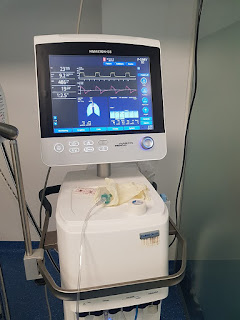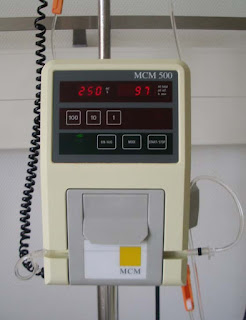Hi friends!!!
Today we are going to discuss about ultrasound machine. Ultrasound is a important diagnostic and therapeutic device in medical field. Therefore it is important for every healthcare professionals and biomedical engineers to know in detail about ultrasound.
Let’s get into the topic.
WHAT IS ULTRASOUND?
Sound generally means what the human ear can hear. All vibrations including sound waves have frequencies. Frequency means how often something vibrates per second. So we can call frequency as vibrations per second. The unit of frequency is Hertz. The human ear can hear frequencies between 20 Hz to 20000 Hz. Any sound with a frequency above 20000 Hz is called as Ultrasound. In medical field ultrasound machine uses high frequency sound waves to produce images of the body.
WHAT IS THE TECHNOLOGY USED?
Ultrasound works based on the principle called PIEZOELECTRIC EFFECT. Ultrasound transducer has a array of piezoelectric crystals. When these crystals are accelerated by electric current, the crystal vibrates and produces high frequency sound waves likewise when sound waves hit the crystal they produce electric currents. Sound waves from the transducer probe propagate into the body and tissues. At each tissue plane, a proportion of sound waves is reflected back and hits the crystal. Again the crystal vibrates and creates the electric current. This electric current is processed to form the image in the monitor. The same crystal can be used to send and receive sound waves.
HOW DOES ULTRASOUND CAPTURE AN IMAGE?
When sound waves propagate into the body, at the interface of sound waves following reactions may take place.
Absorption: Energy is captured by the tissue and them converted back to heat
Reflection: Occurs at the interfaces between tissues of different acoustic properties.
Scattering: Beam hits irregular interface and beam gets scattered.
Transmission: Sound waves pass through the body interface.
The amount of reflected or transmitted energy can be detected and provides information about the size of the reflector. The travel time of the sound can be measured and this provides information about the distance that the sound has traveled. The amount of sound waves reflected is plotted versus the time. It gives information about the size and location of the reflector (tissue or organ) that reflects the sound.
Let’s take a look at some examples. Ultrasound will travel through blood in the heart chamber, but if it hits a heart valve, it will reflect back. It will travel straight through the gallbladder if there are no gallstones, but if there are stones, it will reflect back from them. The denser the object the ultrasound hits, the more of the ultrasound bounces back.
TRANSDUCER PROBE
The shape of the probe determines its field of view and the frequency of sound waves produced determines the penetration depth of sound waves and resolution of the image. High frequency increases the resolution and decreases the depth of penetration.
The probe also has a sound absorbing substance called Backing (damping) block layered on the back of the piezoelectric element to absorb the back reflections from the probe itself and an acoustic lens to help focus the emitted sound waves.
Probe also has a Matching layer to minimize the acoustic impedance between the transducer and the patient. When an ultrasound beam encounters two regions of very different acoustic impedances, the beam is reflected or absorbed.
Probes can be moved across the bodies and some probes are designed to be inserted into the various openings of the body.
WHAT ARE THE TYPES OF TRANSDUCER PROBES?
SECTOR SCANNER
Fan shaped beam and smaller surface required for contact.
LINEAR SCANNER
Rectangular beam and larger contact area is required.
CURVILINEAR SCANNER
Smaller scan head and wider field of view.
WHAT ARE THE CATEGORIES OF TRANSDUCERS?
Normal Beam: The sound beam is introduced into the body at 90 degrees to the surface.
Angle Beam: The sound beam is introduced into the body at any angles other than 90 degrees.
The selection between normal beam and angle beam depends upon the selection of the feature of interest.
Contact Testing: In contact testing a couplent like gel, oil or water is used between the transducer and body surface.
Immersion testing: Here the body surface and transducer are immersed in a water bath. It allows better movement of transducers while allowing the consistent coupling.
Single element transducer: It has only one crystal which acts both as transmitter and receiver. A way to improve near surface resolution in single element transducer is to use a delay line. Delay line provides a time gap between the transmission of sound waves and reception of returning echo’s.
Dual element transducer: It has two crystals; one acts as a transmitter and other as a receiver. It has better near surface resolution because the second transducer does not have to perform transmit function before receiving the returning echo’s.
Now I hope you have acquired some knowledge about Ultrasound machine. We will see in detail Modes of ultrasound and artifacts of ultrasound in our next blog.
Please check out for the link below.
ULTRASOUND – PART 2
NOTE: Dear friends!!! … Please do comment a topic related to Biomedical, so that we can discuss it in future blogs.
Check out for my other blogs
DON’T FORGET TO FOLLOW THIS BLOG PAGE
DROP YOUR MAIL ID TO GET IMMEDIATE UPDATES
If you find this blog post knowledgeable, comment & share it with a friend!






It's a good job and I believe people will gain more experience from your project
Thank your for your appreciation
Good job. I would really love to know about the artifacts of ultrasound in your next blog. Pls keep me posted. Thanks.Jacobson
Thank you for your appreciation. Please check out for ULTRASOUND PART 2
I love this.God bless you.